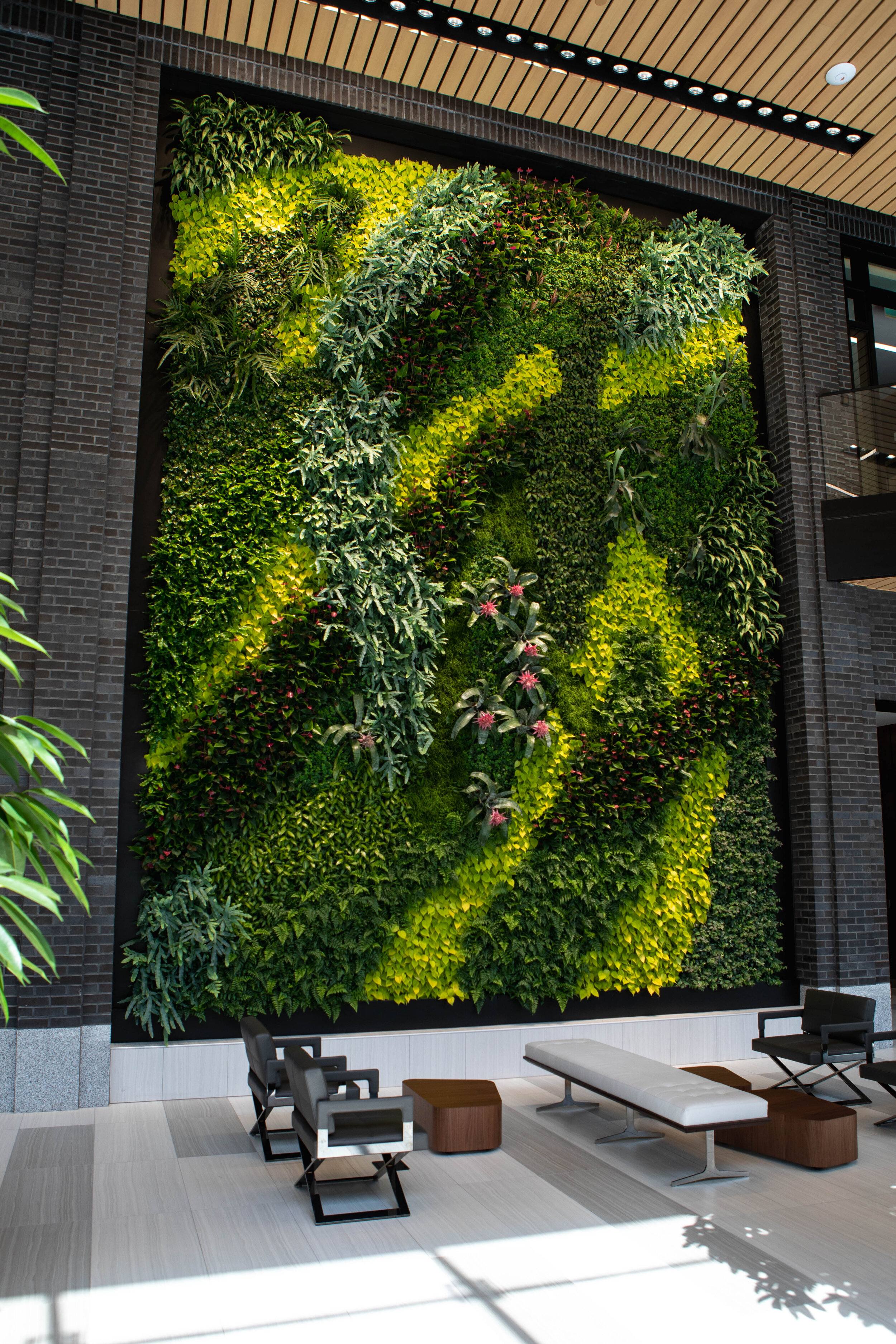An Architect’s Guide To: Living Wall Systems
Table of Contents Show
Biophilic Design trends are emerging especially in the form of interior and exterior Living Wall systems.
However, like any industry, as the market becomes saturated with new players and self-proclaimed specialists, the quality of products will vary. Largely because competitive advantage is no longer associated with function and features of technology, but rather placement and position in the marketplace. Now differentiating factors are measured by brand following, social media influence, and a carefully curated brand image. This is how consumers are reported to be forming bonds with products.
With fashion or DIY furniture, the risks are fairly low for superficial purchasing. However, in the case of Living Wall systems that are in the five to six figure range, the consequences are rippled throughout; and everyone involved in the project (architects, construction managers, designers and clients) can suffer.
What Is Urbanstrong’s Technology-Agnostic Approach to Living Walls?
At Urbanstrong, we describe ourselves as “technology agnostic” in that we’re not beholden to any one manufacturer.
When it comes to Living Walls, we definitely do not subscribe to the old adage “one size fits all.” There is a time and place for each Living Wall system and we make it a point to make all our new clients aware of this. We work with a broad range of different technologies to ensure that we ideally have at least a couple potential solutions that will work for our clients’ unique needs.
And although we maintain a diversified portfolio, we still keep to a thorough vetting process with our vendors, so we are still able to offer the best solution for our clients’ budget and design goals.
In this post we will be judging the systems in five categories, which will be marked by the icons below. Water consumption, eco-friendly materials, overall aesthetics, plant vitality, and price. Let’s take a look at the tiers of Living Wall systems on the market today and the pros and cons of each.
Hydroponic Living Wall by EcoWall
1. What Is a Hydroponic Living Wall?
This is what we refer to as our ‘’Tesla’’ of Living Walls. Everything about this wall is superior and is raising the bar for sustainability. The most sustainable Living Wall system on the market due to its low water consumption (high water efficiency), ultra-low plant replacement rate, and overall longevity. The proprietary system is a blend of inorganic planting material that can be custom cut to any size or angle to accommodate an architect’s unconventional design. This system comes with pre-grown panels that are grown locally here in New Jersey. The benefit here is that on the day after install, we leave the client with a lush tapestry of stabilized foliage. Not to mention, the truly unique and exotic plant palette that is made possible due to the sourcing of rare species and propagation in our manufacturer’s greenhouse. In other words, we can offer the client an extensive list of rare species that you won’t find in any other Living Wall in the U.S. This system can run anywhere from $180-$245/sf which includes everything from materials to installation.
Water consumption ⭐⭐⭐⭐ Eco-friendly Materials ⭐⭐⭐⭐⭐ Overall aesthetics ⭐⭐⭐⭐⭐ Plant Vitality ⭐⭐⭐⭐⭐ Price $$$$
Felt Living Wall by Florafelt
2. Should You Choose a Felt-Based Living Wall?
This is somewhat of a hybrid Living Wall system in the sense that it is hydroponic but does contain some soil in the plant pockets. The felt-based system is flexible to a certain point and is made from recyclable material. The plants are installed in the pockets on-site, so the wall will look nice and mostly full after completion. However, considerations need to be made for when the plants inevitably grow and compete for space on the wall. A result of those considerations can be sporadic bare areas or immediate plant replacements due to shading from larger leaves. Due to some soil presence, there is a risk of attracting pests, growing mold and experiencing occasional soil droppings. The felt material allows for some moisture retention (around 30%) but also provides airflow, drying the felt out quicker. However, because the felt is so drying, the irrigation needs to be run several times a day or for longer periods which can increase your water bill. This system can run anywhere from $160-$220/sf.
Water consumption ⭐⭐ Eco-friendly Materials ⭐⭐⭐ Overall aesthetics ⭐⭐⭐⭐ Plant Vitality ⭐⭐⭐ Price $$$
Preserved Moss Panels by Urbanstrong
3. What Are the Benefits of a Preserved Moss Wall?
Reliable and zero maintenance, our preserved moss and folia line is a great alternative to a living wall when plumbing or electricity is not available. Think taxidermy but with moss and folia species; the species are treated in food-safe, organic glycerin. Urbanstrong’s treatment preserves the species’ vibrant color, soft texture, and natural scent. The moss adheres to a hard backboard that is extremely flexible and can be custom cut into whatever desired shape or form. Logos, stencils, and digital displays can be incorporated, seizing the opportunity to bolster any company’s branding. A preserved moss wall can run anywhere from $60-$100/sf depending on the framing and overall aesthetic.
Water consumption (no water needed) Eco-friendly Materials ⭐⭐⭐ Overall aesthetics ⭐⭐⭐⭐ Plant Vitality ⭐ Price $$
Modular Living Wall by Urbanstrong
4. Is a Modular Cassette Living Wall Right for Small Budgets?
This system is best for retrofits when a cold water and drainage line are not within the design parameters or budget. The gutters mount to the wall with drywall screws and anchors; no different than installing a shelf or picture frame. The semi-automated irrigation system is achieved by capillary wicking action and the gutters double as a reservoir. The plant cassettes make it easy to pop out and replace plants from time to time or move around to curate a fresh aesthetic. The wall has decent coverage, however, when you are up close you can see the guts of the system; making it a bit of a “Monet”. This is most suitable for small to medium-sized projects where the client or homeowner is willing to get hands-on. This system is anywhere from $140-$190/sf.
Water consumption ⭐⭐⭐⭐ Eco-friendly Materials ⭐⭐⭐ Overall aesthetics ⭐⭐ Plant Vitality ⭐⭐ Price $$.
Trellis Wall by Greenscreen
5. How Does a Trellis Wall Compare to Other Vertical Garden Systems?
The trellis is sometimes referred to as a “green wall” or “vertical garden”. However, despite its vertical orientation, trellis systems consist of a very different design, function, and mounting method. These systems come in all shapes and sizes but ultimately they are a grid/cable-like structure and specifically host trailing or vining species that can climb up and further support themselves. Planters are installed at the base of the fencing or cables which can take 8-10 months for the vines to mature and cover the majority of the building’s facade. In winter, bare spots will occur from dead plants, if not the entire wall. Although trellis systems can be designed to incorporate automated irrigation, usually they are installed with the understanding that they will be manually watered and/or grow with nature’s conditions. Given these systems are about a fourth of the cost of a traditional Living Wall system, they are best for smaller budgets and parking garages where the facade is inaccessible and will only be admired from afar. These systems are anywhere from $40-$80/sf.
Water consumption ⭐⭐ Eco-friendly Materials ⭐ Overall aesthetics ⭐⭐ Plant Vitality ⭐⭐ Price $
Potted-rack system by Gsky
6. Why Is the Potted-Rack System Common but Controversial?
This infamous potted-rack system can be seen in several office buildings around the country. It is known for its lightweight engineering and inexpensive price point. A lot of landscapers and horticulture enthusiasts have started offering this system due its simple installation and easy planting. It is safe to say this is an accessible product in more ways than one. However, the main reason it is so attractive to these distributors is the same reason it is not sustainable. The plants never leave the 4’’ pots that they come in from the nursery. If you are a plant parent, you understand how detrimental this is to the plant. After, 8-12 months, the plants become root-bound or ‘potted out.’ By design, the plants in these racking systems do not grow or thrive but are held at their tiny size. Miscalculating the level of lighting or watering can result in wilting, yellowing, browning of the leaves, and eventual death of the plant. The fixed racking system means plants cannot be transplanted to a larger pot so they are thrown out and replaced frequently. This becomes increasingly more expensive, wasteful, and an unsustainable approach to vertical gardening. This is also why you rarely see any mature plants in a potted system living wall. Having to replace dozens, if not hundreds of plants (depending on the size of your wall) every year is a cringing thought for everyone in the industry and gets expensive for the client. However, there is a time and place for all living wall systems. This system is anywhere from $120-$180/sf.
Water consumption ⭐⭐ Eco-friendly Materials ⭐ Overall aesthetics ⭐⭐ Plant Vitality ⭐ Price $$
Conclusion
Choosing the right living wall system means balancing design, function, and maintenance needs. Whether you need a no-maintenance moss wall or a lush hydroponic green wall, Urbanstrong is ready to consult, design, and deliver the best solution for your project. Contact us to learn more.
About The Author
Lily Turner is a biophilic designer, project manager, and living wall design-build specialist with extensive experience across the United States. She brings a unique perspective on integrating social, environmental, and economic values into living architecture to create greener, more sustainable urban cities.
Lily collaborates closely with architects, designers, and contractors to deliver tailored living wall solutions that align with budget, design goals, and project scale. She is also the Chair of the Green Roofs for Healthy Cities’ Living Wall Committee and an active member of the Green Plants for Green Buildings Committee, advocating for innovative green infrastructure in the built environment.








